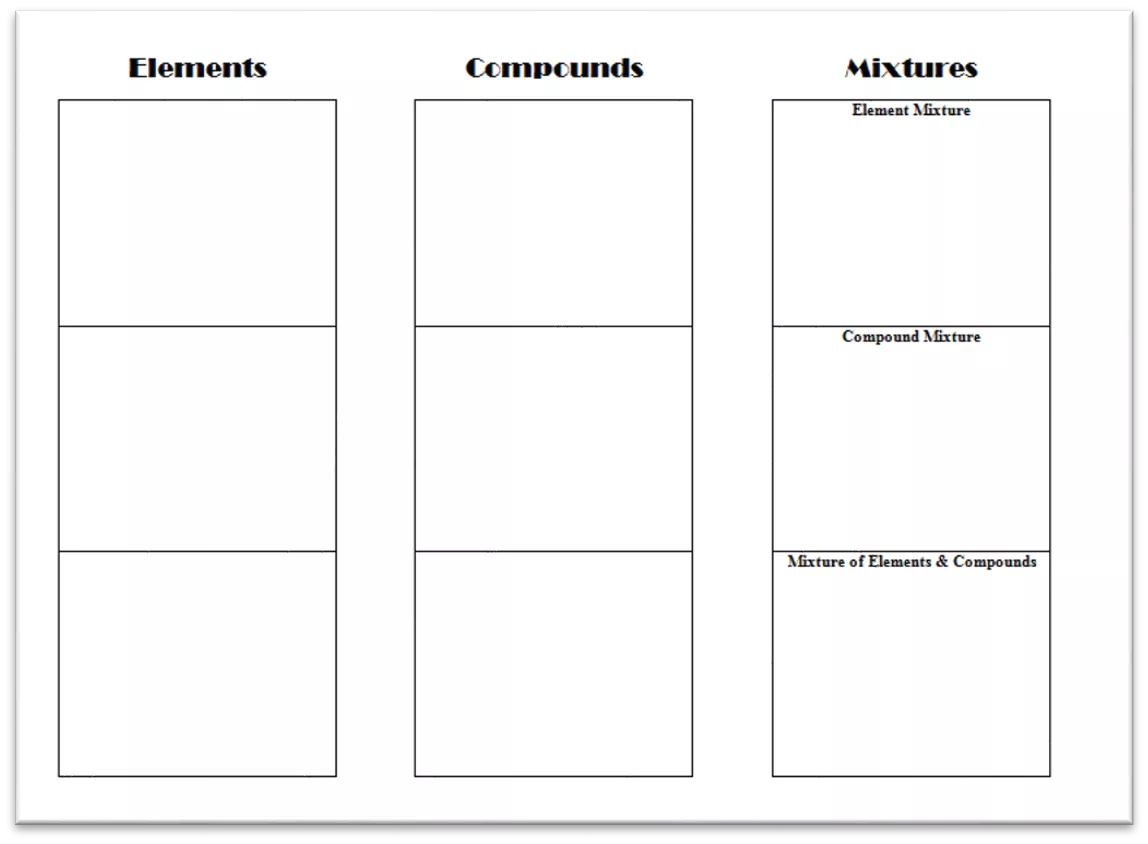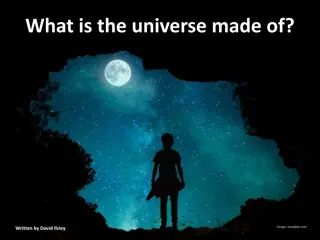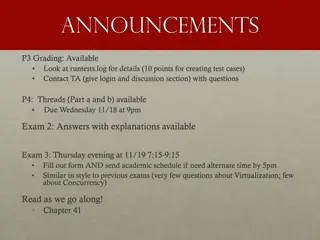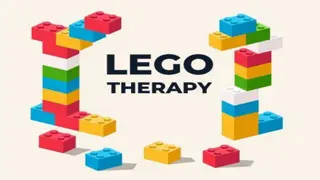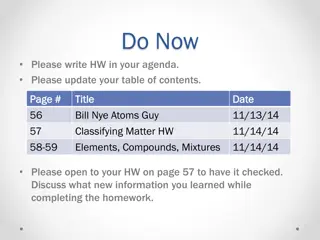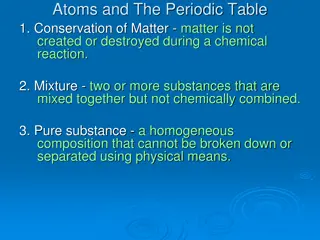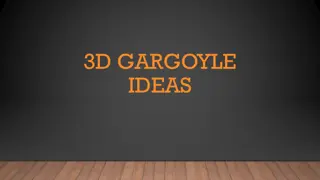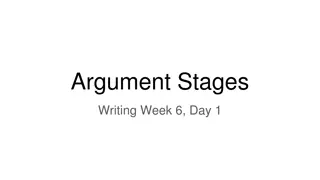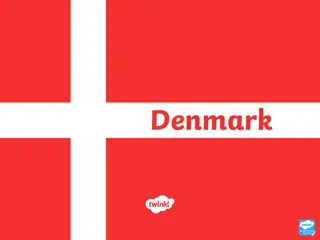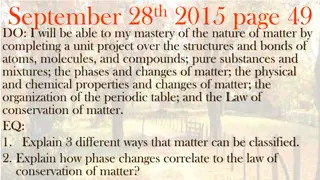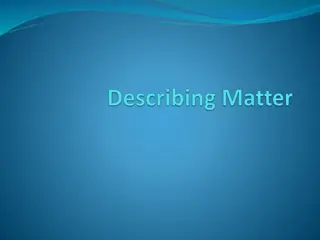Understanding Matter through LEGO Building Blocks
Explore the concept of elements and compounds by sorting LEGO blocks based on color and creating models to represent atoms and compounds. Learn about chemical bonding and how to depict different elements and compounds using LEGO pieces in an engaging hands-on activity.
Download Presentation

Please find below an Image/Link to download the presentation.
The content on the website is provided AS IS for your information and personal use only. It may not be sold, licensed, or shared on other websites without obtaining consent from the author. Download presentation by click this link. If you encounter any issues during the download, it is possible that the publisher has removed the file from their server.
E N D
Presentation Transcript
Building Blocks of Matter Glue the worksheet on page __. Get a bag of LEGOs from your teacher. Sort the LEGOs into 4 piles based on their color. Make sure the blocks are not connected together. Image result for legos Project developed by T. Tomm 2017 http://sciencespot.net/
Elements vs. Compounds LEGOs that are not snapped together are not chemically bonded to each other. These would be considered elements. LEGOs snapped together represent a chemical bond forming one molecule of a compound. One block = One atom of an element Each color is a different ELEMENT.
Elements Challenge 1 Challenge 1: Make a model that represents two atoms of an element. Draw blocks and shade them with colored pencils to make your model. 2B Label using the symbol = first letter of the color. Add coefficients to show how many atoms of the element you have. 2NaCl COEFFICIENT
Elements Challenge 2 Challenge 2: Make a model that represents three atoms of one element. Draw blocks and shade them with colored pencils to make your model. 2B Write an expression to show this. What coefficient will you need for three atoms of an element? 3Y
Elements Challenge 3 Challenge 3: Make a model that represents four atoms of an element. B Draw blocks and shade them with colored pencils to make your model. What coefficient will you need for four atoms of an element? 3Y 4G
Compounds Has 2 or more different elements bonded together. LEGOs snapped together represent a chemical bond forming one compound. As we learned, LEGOs that are not snapped together are not chemically bonded to each other. These would be considered elements. Since the Lego blocks are representing compounds, they must be snapped together. SUBSCRIPTS are used to show how many of each atom are in a compound. H2O SUBSCRIPT
Compound Challenge 1 Challenge: Create a compound consisting of one atom of three different elements (i.e. use 3 different colored blocks.) BYG (any order) Make a model of the compound by drawing blocks and shading them with colored pencils. Write the chemical formula using the first letter of the color as the symbols.
Compound Challenge 2 Challenge: Create a compound with 2 atoms of one element and one atom of two different atoms. BYG (any order) Make a model of the compound by drawing blocks and shading them with colored pencils. B2Y Write the chemical formula using the first letter of the color as the symbols. Add subscripts to show how many atoms of that element are in the compound. (any order) H2O SUBSCRIPT
Compound Challenge 3 Challenge: Create a compound with at least four different elements. BYG (any order) Make a model of the compound by drawing blocks and shading them with colored pencils. Write the chemical formula using the first letter of the color as the symbols. B2Y (any order) Use subscripts to show how many of each atom is included in the compound. Y2R2B (any order)
Mixtures Not Chemically Combined Elements Simplest pure substance made up of only one type of atom. Compound Two or more elements chemically combined. Mixture Two or more substances mixed together, but not chemically combined. Notes: Since we are creating mixtures, we use ADDITION signs to show what is added together. SUBSCRIPTS are used to show how many of each atom are in a compound, while COEFFICIENTS are used to show that we have more than one element or compound.
Mixtures Challenge 1 Challenge 1: Create a mixture of at least three different ELEMENTS. Make a model of the mixture by drawing blocks and shading them with colored pencils. 2B + Y + R Write the chemical expression using the first letter of the color as the symbols. Remember to use coefficients if needed and addition signs to show what is added together.
Mixtures Challenge 2 Challenge 2 - Create a mixture of at least 2 different COMPOUNDS. Make a model of the mixture by drawing blocks and shading them with colored pencils. 2B + Y + R 2B + Y + R Write the chemical expression using the chemical formulas using addition signs, subscripts, and coefficients as needed. B2Y + G2Y + B2R B2Y + G2Y + B2R Remember to use coefficients and subscripts if needed along with addition signs to show what is added together.
Mixtures Challenge 3 Challenge 3 - Create a mixture of ELEMENTS and COMPOUNDS. Make a model of the mixture by drawing blocks and shading them with colored pencils. 2B + Y + R 2B + Y + R Write the chemical expression using the chemical formulas using addition signs, subscripts, and coefficients as needed. B2Y + G2Y + B2R B2Y + G2Y + B2R Remember to use coefficients and subscripts if needed along with addition signs to show what is added together. B2Y + G2Y + B + R
Mixtures Challenge 3 Challenge 3 - Create a mixture of ELEMENTS and COMPOUNDS. Make a model of the mixture by drawing blocks and shading them with colored pencils. 2B + Y + R Write the chemical expression using the chemical formulas using addition signs, subscripts, and coefficients as needed. Notes: Since we are creating mixtures, we use ADDITION signs to show what is added together. SUBSCRIPTS are used to show how many of each atom are in a compound, while COEFFICIENTS are used to show that we have more than one element or compound. B2Y + G2Y + B2R B2Y + G2Y + B + R
Review Write an expression for each example. 2B + Y + R + 2G B2Y + 2G2Y + B2R B2Y + G2Y + B + 2R
Final Challenge Use all your Lego blocks to represent a chemical substance. Write the expression for it. Use all your Lego blocks to represent a chemical substance your choice of elements, compounds, or mixtures. Write the expression for it. Be prepared to share with the class.



